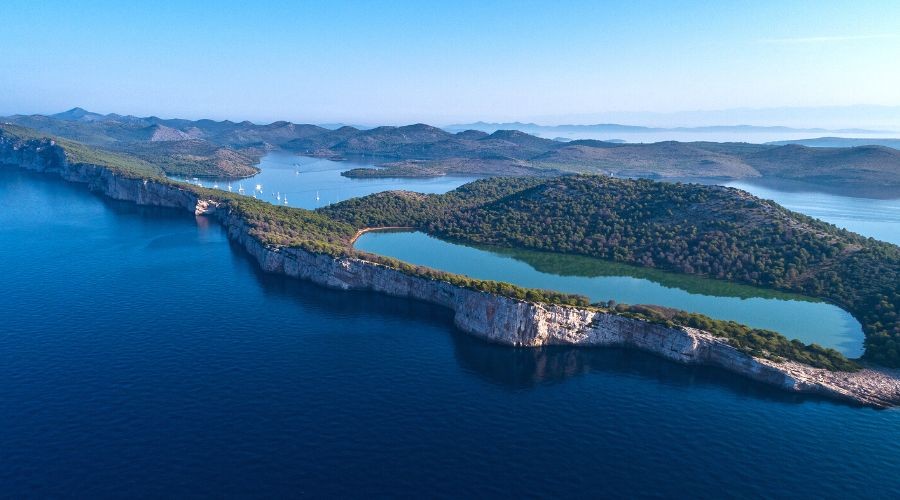
Thanks to its rare geological and geomorphological features and exceptional flora and fauna, it has been a protected area since 1980 and a nature park since 1988. It is a paradise for boaters and a not-to-be-missed destination on your next sailing trip. Dive into the unparalleled beauty of Telašćica with us!
An area that welcomes over 2,500 sunshine hours per year. Where the Croatian fishing tradition was born, dating back to the 10th century. Where steep rocky cliffs mark one of the Adriatic's safest and largest natural harbors, and not to mention one of the most breathtaking. Meet Telašćica, a pristine bay in the southeastern part of Dugi Otok Island.
Brief History
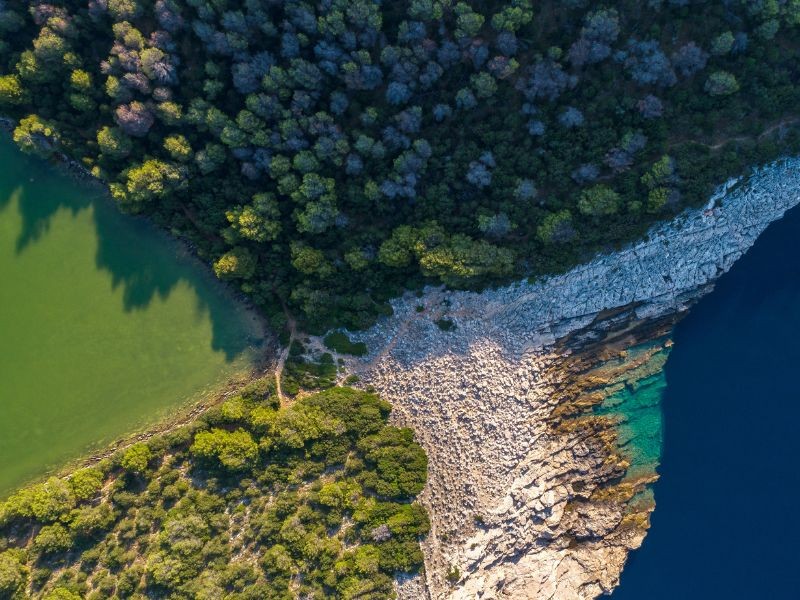
The area got its present appearance at the end of the last ice age when the sea level rose and the lower parts of the then land, which occupied large parts of the Adriatic, were flooded. Numerous islets in the Kornati were formed from the former hills, and the sea entered the three depressions of Telašćica that had been dry. In Latin, ‘tri lagus’ means three lakes, which became ‘Telagus’ and finally ‘Telašćica’. It is assumed that the island of Kornati was connected to the mainland until 9-10 thousand years ago and with Dugi Otok until 2100-2400 years ago, or during ancient Greece.
Telašćica has been inhabited since ancient times, confirmed by the remains of Roman buildings and pre-Romanesque churches, among which are the churches of Sv. Ivan, Sv. Vikor, Sv. Luka, and Sv. Ante. On Telašćica’s western coast (Stivanje Polje) was the 10th-century settlement of Telagus, after which this bay got its name. As already mentioned, the fishing tradition among Croats began on these shores thanks to records from the 10th century. The Vela Sestrica (Tajer) lighthouse was built during the Austro-Hungarian era in the 19th century.
Geographically part of the Kornati, Telašćica was named after the southernmost part of Dugi Otok split and protruded into the Kornati and ultimately into an expansive bay on the 69-kilometer indented coastline. This natural feature helped Telašćica become the only nature park on the sea in 1988 after it was separated from Kornati National Park.
Where to anchor
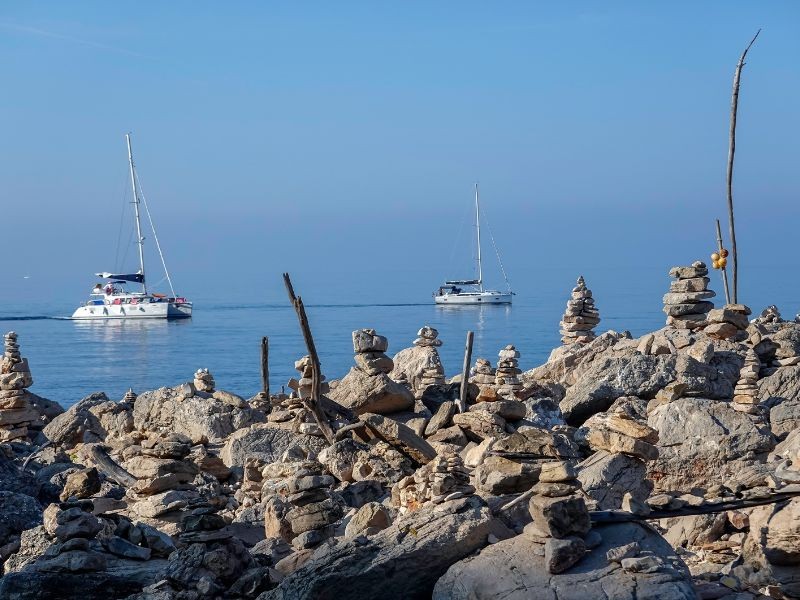
Did you know that Telaščica Bay is the largest and one of the best sheltered natural harbors in the Croatian Adriatic? Well, we may have hinted at that already. Divided into many smaller bays, some with buoys, Telaščica is adorned with six islets and 25 coves that pop out among its cliffs. It’s important to note that although the buoys and anchorages within Telaščica Nature Park are free, a ticket to the park must be purchased to use them.
Ćuška Duboka Bay is a popular place to anchor within the park, while Magrovica Bay in the northern part of the park sits behind the two islands of Donji Školj and Gornji Školj. Not only is it well-protected from the northerly bura wind, but it offers stunning scenic views. The island of Katina is also equipped with a few jetties, namely at Restaurant Aquarius and Restaurant Mare.
While Katina is known as the most beautiful island, we can’t forget to mention the most unusual. Taljurić is a small stone islet that spans 60 m and is only 3 m tall. Built of horizontally layered limestone whose upper layers have been washed away by the waves, this islet is decorated by sea foam when the weather worsens. But best of all? Its surroundings boast an impressive variety of fish!
Restaurants

Taverna Go-Ro is located at the end of Telašćica in Magrovica Bay, which can be reached through Vela and Mala Proversa or the northwest side of Kornati. This small family restaurant has a long-standing tradition, thriving without electricity or running water and instead operating on solar energy and rainwater. Surrounded by olive trees from which the family produces its own oil, this restaurant offers homemade wine, local fish, and produce harvested from their garden. Konoba Škeba is another family-run restaurant in Magrovica Bay serving authentic cuisine from the island and region. Fish and seafood, of course, are king.
Šporka Mare is another popular eatery on Katina Island, while Restaurant Aquarius is on the same island near Mala Proversa.
Finally, Kršovica Bay and its restaurant are located in the heart of Telašćica Nature Park. The restaurant operates as part of OPG Jagić, promising local produce and many grilled seafood dishes.
About Telašćica Nature Park
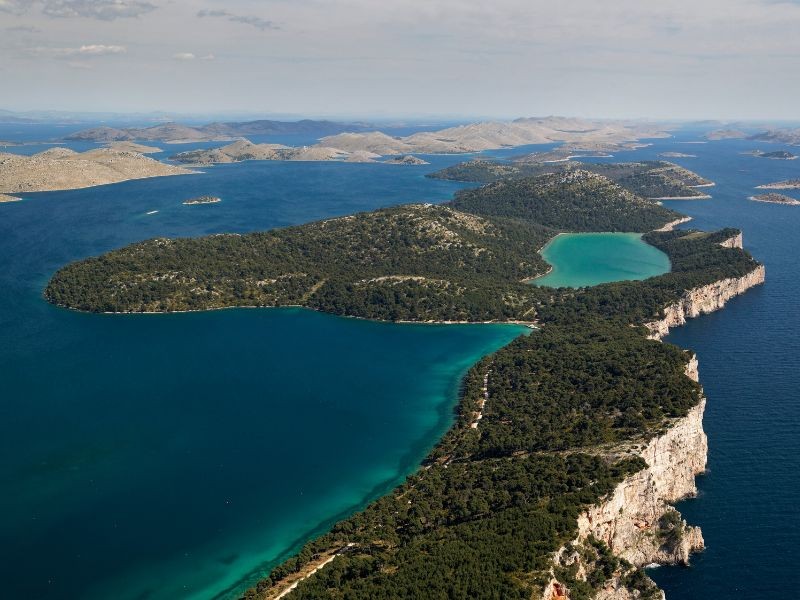
We’ve already mentioned that Telašćica Bay is located in the southeastern part of Dugi Otok Island. It received the status of a protected area in 1980 and a nature park in 1988, thanks to its flora and fauna, geological and geomorphological phenomena, seabed communities, and archaeological heritage. But what are some of its prominent features? And what can you do there as a visitor?
Activities
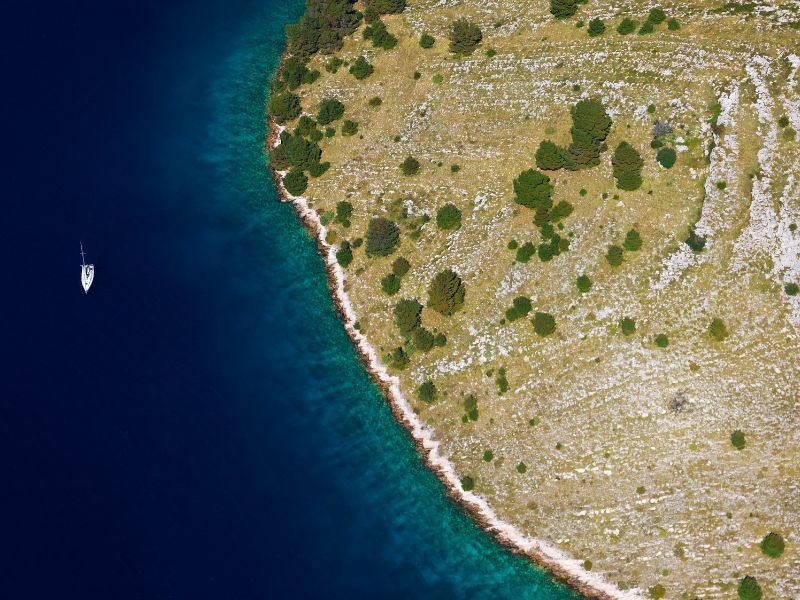
Telašćica Bay is one of the Adriatic Sea's safest, most beautiful, and largest natural harbors. The total area of Telašćica Nature Park is 70.50 km2, 25.95 km2 on Dugi Otok and neighboring islets, and 44.55 km2 on the sea. Its trademark cliffs rise to 161 meters above the sea and descend to a depth of 90 m, while 25 coves dance around the area, wrapped by thriving Mediterranean vegetation. There are around 500 plant species and fauna, while the seabed boasts about 300 plant and 300 animal species!
Cliffs
The magnificent Telašćica cliffs are the tallest here than anywhere else on the entire Adriatic. They stretch for kilometers along the coast and can reach up to 150 meters! In the northwest, they extend beyond the boundaries of Telašćica Nature Park, culminating on the Gračina cliff, which rises 208 meters above the sea. From there, towards the south, they gradually decrease, and at the foot of the Muravjak peak (180-meters tall), they disappear into the sea.
Lake Mir
Located southwest of Telaščica Nature Park is Lake Mir. This shallow salt lake is about 900 m long, 300 m wide, and 8 meters at its greatest depth. Lake Mir is located in a narrow part of the land between the bay and the open sea, and its high salinity is due to significant evaporation and the lake’s enclosure. What also makes Lake Mir stand out, however, is its unique inhabitants - Dalmatian donkeys.
Sestrica Vela Lighthouse
At the park's edge is the small island of Sestrica Vela, adorned by the Tajer Lighthouse. This well-preserved lighthouse was built in 1876 and sits 47 meters above sea level. The lighthouse can be visited today, though it takes a nature walk through a 100-year-old forest to get there. And if you want to go inside the lighthouse? Well, you’ll need to book ahead.
Grpašćak
Considered Telašćica Nature Park’s main attraction, Grpašćak is a military fort that has transformed into a tourist center located on the highest cliff in the Adriatic Sea. Come here for the views but stay to learn about the natural and cultural values of Telašćica, buy souvenirs, or keep your eyes peeled by dolphin watching! Better yet? Entrance to Grpašćak is included in your Telašćica Nature Park ticket!
Trails
But it’s not all about the sea at Telašćica Nature Park - there are many walking trails, too! Perhaps most popular is the Lake Mir trail, which circles 2.2 km around the famous lake. Another route takes you through the medicinal plants from Grpašćak to Gmajno Polje (1 km), while the Mir Bay to Lake Mir trail is 2.5 km. The underwater course in Tripuljak Bay is the most exciting, which takes you on a 200-meter-long underwater adventure to see how life thrives under the sea!
Diving
Diving is also popular at Telašćica Nature Park, however, in protected zones. Divers can explore a variety of corals and stones, along with various fish. The seabed is rich and preserved, primarily because these are protected areas. And as you likely assumed, fishing is prohibited. Telašćica Nature Park actually became the first no-fishing zone in Croatia back in 2020!
